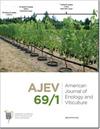Production Method and Wine Style Influence Metal Profiles in Sparkling Wines
IF 1.8
3区 农林科学
Q3 BIOTECHNOLOGY & APPLIED MICROBIOLOGY
引用次数: 3
Abstract
The elemental composition of wine provides important information about origin, authenticity, and sensory considerations. Although various wine regions and varieties of still wines have been extensively studied, limited research has evaluated the metal profiles of sparkling wines, which can be produced via the bottle-fermented traditional method (TM) or the tank-fermented Charmat method (CM) in both rosé and non-rosé styles. In this study, 73 commercial sparkling wines from Canada’s Niagara Peninsula were analyzed by inductively coupled plasma-optical emission spectrometry and inductively coupled plasma-mass spectrometry to quantify 28 metal ions (silver [Ag], aluminum [Al], arsenic [As], boron [B], barium [Ba], beryllium [Be], calcium [Ca], cadmium [Cd], cobalt [Co], chromium [Cr], copper [Cu], iron [Fe], potassium [K], magnesium [Mg], manganese [Mn], molybdenum [Mo], sodium [Na], nickel [Ni], lead [Pb], antimony [Sb], selenium [Se], tin [Sn], strontium [Sr], titanium [Ti], thallium [Tl], uranium [U], vanadium [V], zinc [Zn]). All metal levels were below internationally regulated maximum limits. Higher mean levels of Cr, Ni, and Sr (0.021 ± 0.008 mg/L, 0.018 ± 0.004 mg/L, and 0.32 ± 0.07 mg/L, respectively) and lower mean levels of B (3.0 ± 0.6 mg/L) were identified in CM compared with TM wines. Cr and Ni are of particular interest because of their association with stainless steel contact during CM production. In addition, the results identified higher mean levels of K (613 ± 153 mg/L) and lower mean levels of Cu (0.034 ± 0.036 mg/L) in rosé wines compared with non-rosé style wines. These results represent the first investigation of metal content in Canadian sparkling wines and identify important elemental differences related to production technique that can inform future authenticity assessments.生产方法和葡萄酒风格对起泡酒金属剖面的影响
葡萄酒的元素组成提供了关于原产地、真实性和感官考虑的重要信息。尽管对不同的葡萄酒产区和品种的静止葡萄酒进行了广泛的研究,但对起泡酒的金属结构进行评估的研究有限,起泡酒可以通过传统的瓶发酵法(TM)或罐式发酵法(CM)在玫瑰红和非玫瑰红两种风格中生产。本研究采用电感耦合等离子体光学发射光谱法和电感耦合等离子体质谱法对加拿大Niagara半岛的73种商品起泡酒进行了28种金属离子(银[Ag]、铝[Al]、砷[As]、硼[B]、钡[Ba]、铍[Be]、钙[Ca]、镉[Cd]、钴[Co]、铬[Cr]、铜[Cu]、铁[Fe]、钾[K]、镁[Mg]、锰[Mn]、钼[Mo]、钠[Na]、镍[Ni]、铅[Pb]、锑[Sb]、硒[Se]、锡[Sn]、锶[Sr]、钛[Ti]、铊[Tl]、铀[U]、钒[V]、锌[Zn])。所有的金属含量都低于国际规定的最高限度。Cr、Ni和Sr的平均含量分别为0.021±0.008 mg/L、0.018±0.004 mg/L和0.32±0.07 mg/L,而B的平均含量则为3.0±0.6 mg/L。Cr和Ni是特别感兴趣的,因为它们与CM生产过程中的不锈钢接触有关。此外,与非红蔷薇风格的葡萄酒相比,红蔷薇葡萄酒的平均钾含量(613±153 mg/L)更高,铜含量(0.034±0.036 mg/L)更低。这些结果代表了加拿大起泡酒中金属含量的首次调查,并确定了与生产技术相关的重要元素差异,可以为未来的真实性评估提供信息。
本文章由计算机程序翻译,如有差异,请以英文原文为准。
求助全文
约1分钟内获得全文
求助全文
来源期刊

American Journal of Enology and Viticulture
农林科学-生物工程与应用微生物
CiteScore
3.80
自引率
10.50%
发文量
27
审稿时长
12-24 weeks
期刊介绍:
The American Journal of Enology and Viticulture (AJEV), published quarterly, is an official journal of the American Society for Enology and Viticulture (ASEV) and is the premier journal in the English language dedicated to scientific research on winemaking and grapegrowing. AJEV publishes full-length research papers, literature reviews, research notes, and technical briefs on various aspects of enology and viticulture, including wine chemistry, sensory science, process engineering, wine quality assessments, microbiology, methods development, plant pathogenesis, diseases and pests of grape, rootstock and clonal evaluation, effect of field practices, and grape genetics and breeding. All papers are peer reviewed, and authorship of papers is not limited to members of ASEV. The science editor, along with the viticulture, enology, and associate editors, are drawn from academic and research institutions worldwide and guide the content of the Journal.
 求助内容:
求助内容: 应助结果提醒方式:
应助结果提醒方式:


